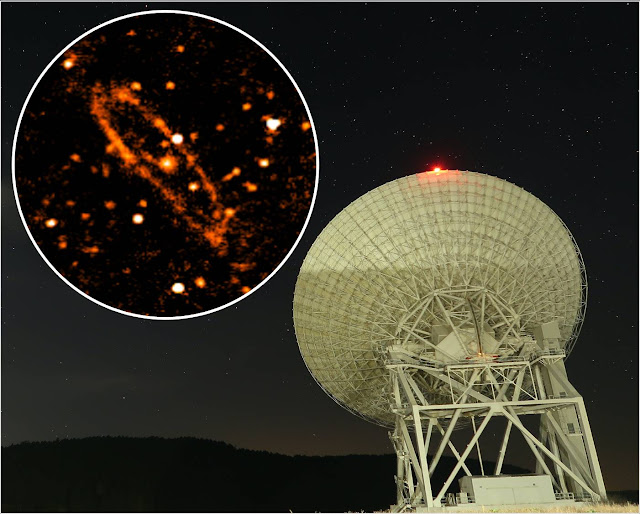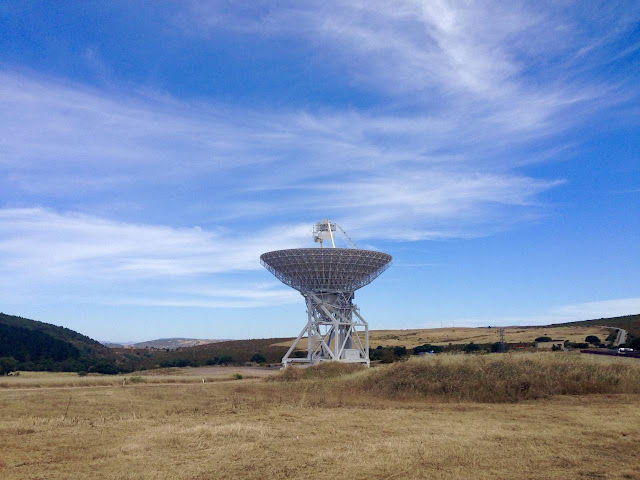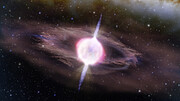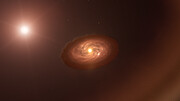Illustration of a Short Gamma-Ray Burst Caused by a Collapsing Star
Videos
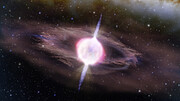
Cosmoview Episode 31: Astronomers Uncover Briefest Supernova-Powered Gamma-Ray Burst
CosmoView Episodio 31: Joven astrónomo chileno descubre supernova que produjo intrigante señal de rayos gamas
Gemini North identifies collapsing star as the surprising cause of a “fizzled” gamma-ray burst
Astronomers have discovered the
shortest-ever gamma-ray burst (GRB) caused by the implosion of a massive
star. Using the international Gemini Observatory, a Program of NSF’s
NOIRLab, astronomers identified the cause of this 0.6-second flurry of
gamma rays as a supernova explosion in a distant galaxy. GRBs caused by
supernovae are usually more than twice as long, which suggests that some
short GRBs might actually be imposters — supernova-produced GRBs in
disguise.
Gamma-ray bursts (GRBs)
are among the brightest and most energetic events in the Universe, but
scientists are still figuring out exactly what causes these fleeting
events [1].
Astronomers divide GRBs into two broad categories based on their
duration. Short GRBs blaze into life in less than two seconds and are
thought to be caused by the merging of binary neutron stars [2]. Those that last longer are classified as long GRBs, and have been associated with supernova explosions caused by the implosions of massive stars [3].
However, the recent discovery of the shortest-ever GRB produced during a
supernova shows that GRBs don’t fit neatly into the boxes astronomers
have created for them.
“This discovery represents the shortest gamma-ray emission caused by a supernova during the collapse of a massive star,”
commented Tomás Ahumada, who led this research and is a PhD candidate
at the University of Maryland and astronomer at NASA’s Goddard Space
Flight Center. “It lasted for only 0.6 second, and it sits on the brink between a successful and a failed gamma-ray burst.”
The team believes that this and some other supernova-related GRBs are
appearing short because the jets of gamma rays that emerge from the
collapsing star’s poles aren’t strong enough to completely escape the
star — almost failing to produce a GRB — and that other collapsing stars
have such weak jets that they don’t produce GRBs at all.
This discovery could also help explain an astronomical mystery. Long
GRBs are associated with a specific type of supernova (called Type
Ic-BL). However, astronomers observe many more of these supernovae than
long GRBs. This discovery of the shortest GRB associated with a
supernova suggests that some of these supernova-caused GRBs are
masquerading as short GRBs thought to be created by neutron-star
mergers, and are therefore not getting counted as the supernova kind.
“Our discovery suggests that, since we observe many more of these
supernovae than long gamma-ray bursts, most collapsing stars fail to
produce a GRB jet that breaks through the outer envelope of the
collapsing star,” explained Ahumada. “We think this event was effectively a fizzle, one that was close to not happening at all.”
The team was able to determine that this GRB — identified as GRB
200826A — originated from a supernova explosion thanks to the imaging
capabilities of the Gemini Multi-Object Spectrograph on Gemini North
in Hawai‘i. The researchers used Gemini North to obtain images of the
GRB’s host galaxy 28, 45, and 80 days after the GRB was first detected
on 26 August 2020 by a network of observatories that included NASA’s Fermi Gamma-ray Space Telescope.
Gemini’s observations allowed the team to spot the tell-tale rise in
energy that signifies a supernova, despite the blast’s location in a
galaxy 6.6 billion light-years away.
“This was a complicated endeavor as we needed to separate the light of an already faint galaxy from the light of a supernova,” said Ahumada. “Gemini
is the only ground-based telescope that can do follow-up observations
like this with a flexible-enough schedule to let us squeeze in our
observations.”
This result shows that classifying GRBs based solely on their
duration may not be the best approach, and that additional observations
are needed to determine a GRB’s cause.
"We were originally hunting for merging neutron stars, which are thought to produce short gamma-ray bursts," added Ahumada. "Once
we discovered GRB 200826A, however, we realized that this burst was
more likely to be caused by a collapsing star’s supernova, which was a
surprise!"
“The Gemini observatories continue to shed new light on the
nature of these incredible explosions occurring across the distant
Universe,” said Martin Still, Gemini Program Officer at NSF. “Dedicated
instrumentation arriving for use over the next decade will maintain
Gemini’s leadership in the follow-up of these awe-inspiring cosmic
events.”
Notes
[1] Gamma-ray bursts occur extremely rarely, but
when they do occur they release a spectacular amount of energy. In just a
few seconds, a typical GRB will release more energy than the Sun will
over its 10-billion-year lifetime.
[2] Neutron stars are
some of the smallest, densest, and strangest astronomical objects in
the Universe. Formed by the collapse of massive stars, they compress the
mass of 1.4 Suns into a ball only 10 kilometers across. The material of
neutron stars is as dense as the nucleus of an atom, and a single
teaspoon of neutron-star material would weigh as much as Mount Everest
on Earth. As well as their incredible density, neutron stars are also
intensely hot and possess magnetic fields millions of times stronger
than Earth’s.
[3] A star that has
collapsed under its own gravity at the end of its life is also known as a
collapsar. At the end of their lives, stars run out of the hydrogen
that sustains nuclear reactions in their cores. Without the stabilizing
pressure of these reactions, stars cannot fight gravity, and they
collapse into an exotic stellar remnant. The mass of a star determines
its fate: stars smaller than 1.4 times the mass of the Sun shrink to
white dwarfs, larger stars collapse into neutron stars, and the largest
stars collapse entirely, forming black holes.
More Information
This research was presented in the paper Discovery and Confirmation of the Shortest Gamma Ray Burst from a Collapsar in the journal Nature Astronomy.
The team is composed of Tomás Ahumada (Department of Astronomy, University of Maryland; Astrophysics Science Division, NASA Goddard Space Flight Center; and Center for Research and Exploration in Space Science and Technology, NASA Goddard Space Flight Center), Leo P. Singer (Astrophysics Science Division, NASA Goddard Space Flight Center; Joint Space-Science Institute, University of Maryland), Shreya Anand (Division of Physics, Mathematics and Astronomy, California Institute of Technology), Michael W. Coughlin (School of Physics and Astronomy, University of Minnesota), Mansi M. Kasliwal (Division of Physics, Mathematics, and Astronomy, California Institute of Technology), Geoffrey Ryan (Department of Astronomy, University of Maryland; Astrophysics Science Division, NASA Goddard Space Flight Center), Igor Andreoni (Division of Physics, Mathematics, and Astronomy, California Institute of Technology), S. Bradley Cenko (Astrophysics Science Division, NASA Goddard Space Flight Center; Joint Space-Science Institute, University of Maryland), Christoffer Fremling (Division of Physics, Mathematics, and Astronomy, California Institute of Technology), Harsh Kumar (Indian Institute of Technology Bombay; LSSTC Data Science Fellow), Peter T. H. Pang (Nikhef, Department of Physics, Utrecht University), Eric Burns (Louisiana State University), Virginia Cunningham (Department of Astronomy, University of Maryland; Astrophysics Science Division, NASA Goddard Space Flight Center), Simone Dichiara (Department of Astronomy, University of Maryland; Astrophysics Science Division, NASA Goddard Space Flight Center), Tim Dietrich (Institut für Physik und Astronomie, Universität Potsdam; Max Planck Institute for Gravitational Physics, Albert Einstein Institute), Dmitry S. Svinkin (Ioffe Institute, Polytekhnicheskaya), Mouza Almualla (American University of Sharjah), Alberto J. Castro-Tirado (Instituto de Astrofísica de Andalucía; Departamento de Ingeniería de Sistemas y Automática, Escuela de Ingenieros Industriales), Kishalay De (Division of Physics, Mathematics, and Astronomy, California Institute of Technology), Rachel Dunwoody (School of Physics, University College Dublin), Pradip Gatkine (Division of Physics, Mathematics, and Astronomy, California Institute of Technology), Erica Hammerstein (Department of Astronomy, University of Maryland), Shabnam Iyyani (Inter-University Centre for Astronomy and Astrophysics), Joseph Mangan (School of Physics, University College Dublin), Dan Perley (Astrophysics Research Institute, Liverpool John Moores University), Sonalika Purkayastha (National Centre for Radio Astrophysics, Tata Institute of Fundamental Research), Eric Bellm (DIRAC Institute, Department of Physics and Astronomy, University of Washington), Varun Bhalerao (Indian Institute of Technology Bombay), Bryce Bolin (Division of Physics, Mathematics, and Astronomy, California Institute of Technology), Mattia Bulla (Nordita, KTH Royal Institute of Technology and Stockholm University), Christopher Cannella (Duke University, Electrical and Computer Engineering), Poonam Chandra (National Centre for Radio Astrophysics and Swarna Jayanti Fellow, Department of Science & Technology), Dmitry A. Duev (Division of Physics, Mathematics, and Astronomy, California Institute of Technology), Dmitry Frederiks (Ioffe Institute, Polytekhnicheskaya), Avishay Gal-Yam (Department of Particle Physics and Astrophysics, Hebrew University), Matthew Graham (Division of Physics, Mathematics, and Astronomy, California Institute of Technology), Anna Y. Q. Ho (Miller Institute for Basic Research in Science, University of California; Department of Astronomy, University of California – Berkeley), Kevin Hurley (Space Sciences Laboratory, University of California – Berkeley), Viraj Karambelkar (Division of Physics, Mathematics, and Astronomy, California Institute of Technology), Erik C. Kool (The Oskar Klein Centre, Department of Astronomy), S. R. Kulkarni (Division of Physics, Mathematics, and Astronomy, California Institute of Technology), Ashish Mahabal (Division of Physics, Mathematics, and Astronomy, California Institute of Technology), Frank Masci (IPAC, California Institute of Technology), Sheila McBreen (School of Physics, University College Dublin), Shashi B. Pandey (Aryabhatta Research Institute of Observational Sciences), Simeon Reusch (Deutsches Elektronen Synchrotron DESY; Institut für Physik, Humboldt-Universität zu Berlin), Anna Ridnaia (Ioffe Institute, Polytekhnicheskaya), Philippe Rosnet (Université Clermont Auvergne, CNRS; IN2P3, Laboratoire de Physique de Clermont), Benjamin Rusholme (IPAC, California Institute of Technology), Ana Sagués Carracedo (The Oskar Klein Centre, Department of Physics), Roger Smith (Caltech Optical Observatories, California Institute of Technology), Maayane Soumagnac (Department of Particle Physics and Astrophysics, Weizmann Institute of Science, Lawrence Berkeley National Laboratory), Robert Stein (Deutsches Elektronen Synchrotron DESY; and Institut für Physik, Humboldt-Universität zu Berlin), Eleonora Troja (Department of Astronomy, University of Maryland; Astrophysics Science Division, NASA Goddard Space Flight Center), Anastasia Tsvetkova (Ioffe Institute, Polytekhnicheskaya), Richard Walters (Caltech Optical Observatories, California Institute of Technology), and Azamat F. Valeev (Special Astrophysical Observatory, Russian Academy of Sciences).
NSF’s NOIRLab (National Optical-Infrared Astronomy Research Laboratory), the US center for ground-based optical-infrared astronomy, operates the international Gemini Observatory (a facility of NSF, NRC–Canada, ANID–Chile, MCTIC–Brazil, MINCyT–Argentina, and KASI–Republic of Korea), Kitt Peak National Observatory (KPNO), Cerro Tololo Inter-American Observatory (CTIO), the Community Science and Data Center (CSDC), and Vera C. Rubin Observatory (operated in cooperation with the Department of Energy’s SLAC National Accelerator Laboratory). It is managed by the Association of Universities for Research in Astronomy (AURA) under a cooperative agreement with NSF and is headquartered in Tucson, Arizona. The astronomical community is honored to have the opportunity to conduct astronomical research on Iolkam Du’ag (Kitt Peak) in Arizona, on Maunakea in Hawai‘i, and on Cerro Tololo and Cerro Pachón in Chile. We recognize and acknowledge the very significant cultural role and reverence that these sites have to the Tohono O'odham Nation, to the Native Hawaiian community, and to the local communities in Chile, respectively.
Links

